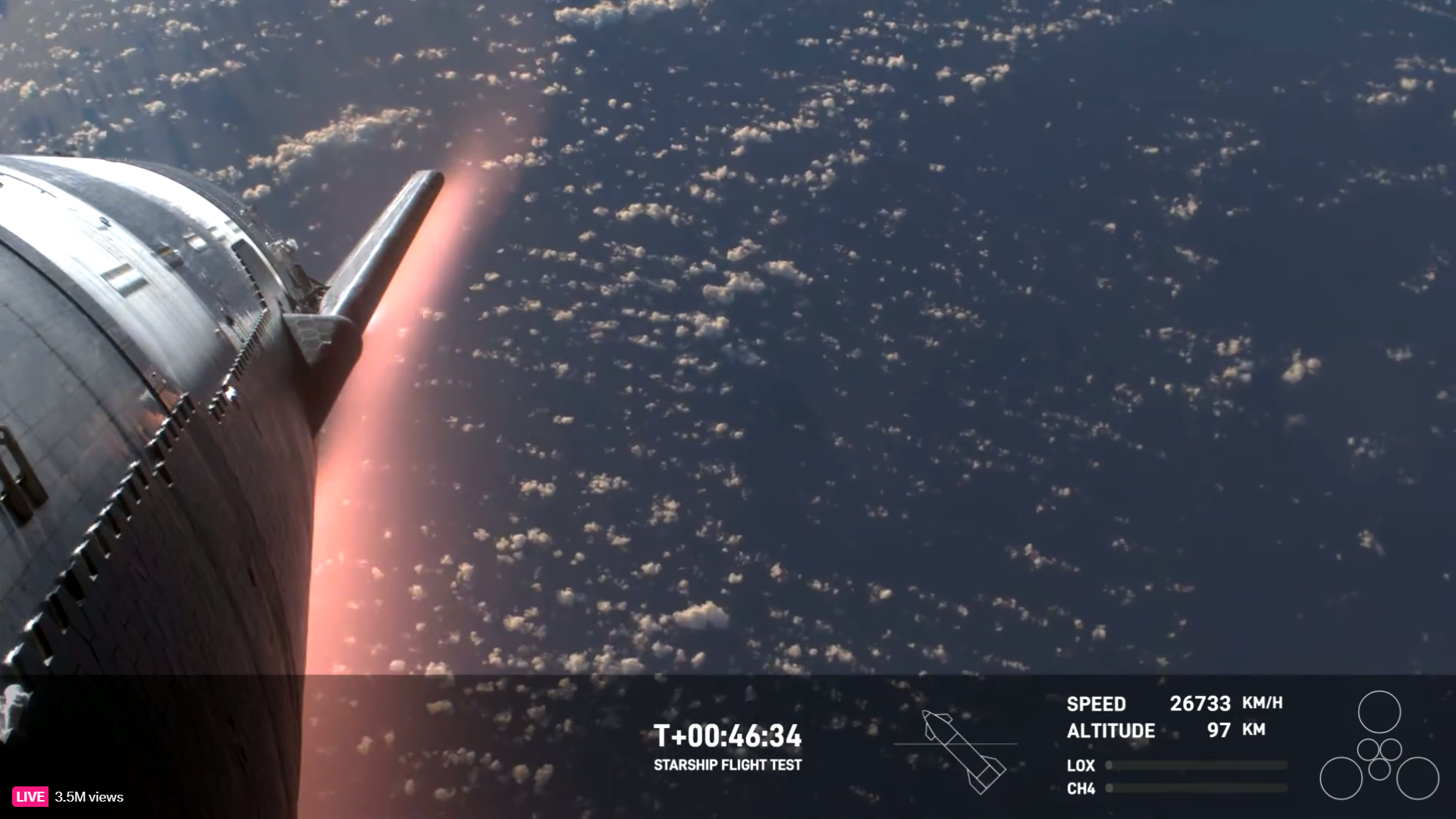Watch SpaceX's Starship reenter Earth's atmosphere in this fiery video
SpaceX's third Starship megarocket made sure its epic demise would be remembered.
Starship launched today (March 14) for the third time ever, soaring into space from SpaceX's Starbase site in South Texas. The giant vehicle notched a number of important milestones, including opening its payload door in space and conducting a propellant-transfer demonstration away from Earth.
Starship's upper stage didn't stick its planned water landing in the Indian Ocean, going dark partway through its fiery descent through Earth's atmosphere. But the ship kept its cameras on during reentry, showing us just how harrowing the ordeal was.
Related: Relive SpaceX Starship's 3rd flight test in breathtaking photos
The upper stage reached orbital velocity and attained a maximum altitude of 145 miles (234 kilometers) today, according to the telemetry data that SpaceX provided during its launch webcast.
The 165-foot-tall (50 meters) spacecraft sent home amazing views from this lofty perch. We saw fluffy white clouds floating above glassy seas, for example, and got peaceful looks at Earth's curving limb against the blackness of space.
But the tone shifted about 46 minutes after launch, when Starship had descended to an altitude of about 62 miles (100 km) — low enough for the atmosphere to start making its presence felt.
Breaking space news, the latest updates on rocket launches, skywatching events and more!
The vehicle's onboard cameras showed clouds of orange blooming against Starship's fins and belly. A few seconds later, these clouds blazed into a wall of superheated plasma that intensified as Starship got lower and lower, experiencing temperatures of up to 2,600 degrees Fahrenheit (1,430 degrees Celsius).
It's tough to send data home through such plasma fields. But Starship managed to do so, using SpaceX's Starlink internet satellites to communicate with its handlers here on Earth, company representatives said.
"Reliable high-speed, low-latency internet around the world — even while traveling at 27,000 km/h through a plasma field," Starlink's official X account wrote shortly after today's flight, in a post that featured a video of Starship's reentry.
Starship kept sending imagery until about 48.5 minutes after launch, when it had descended to an altitude of 48 miles (77 km). All telemetry ceased shortly thereafter, likely indicating when Starship gave up the ghost, breaking apart under extreme frictional forces.
Starship Die Cast Rocket Model Now $69.99 on Amazon.
If you can't see SpaceX's Starship in person, you can score a model of your own. Standing at 13.77 inches (35 cm), this is a 1:375 ratio of SpaceX's Starship as a desktop model. The materials here are alloy steel and it weighs just 225g.
Note: Stock is low so you'll have to act quickly to get this.
Today's test flight was a big leap forward for Starship, the 400-foot-tall (122 meters) vehicle that SpaceX is developing to help humanity settle the moon and Mars. Starship's first two test flights, in April 2023 and November 2023, lasted just four minutes and eight minutes, respectively.
SpaceX will try to make even more Starship progress soon; the company has already built four more of the giant stainless-steel rockets.
"These vehicles are slated for future flight tests just like today's," Siva Bharadvaj, a space operations engineer at SpaceX, said during the launch webcast.
"And, in fact, just this week, we static-fired our next ship that's planning to fly and expect to test the booster as soon as the launch mount is free from today's flight test," he added.

Michael Wall is a Senior Space Writer with Space.com and joined the team in 2010. He primarily covers exoplanets, spaceflight and military space, but has been known to dabble in the space art beat. His book about the search for alien life, "Out There," was published on Nov. 13, 2018. Before becoming a science writer, Michael worked as a herpetologist and wildlife biologist. He has a Ph.D. in evolutionary biology from the University of Sydney, Australia, a bachelor's degree from the University of Arizona, and a graduate certificate in science writing from the University of California, Santa Cruz. To find out what his latest project is, you can follow Michael on Twitter.


